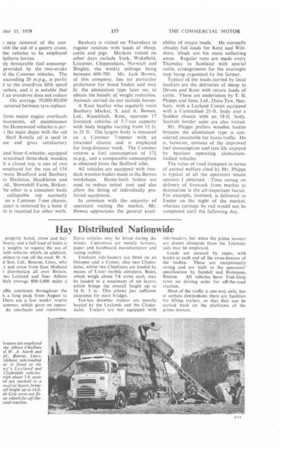Hay Distributed Nationwide
Page 73

If you've noticed an error in this article please click here to report it so we can fix it.
properly baled, straw and hay heavy, and a full load of bales is y weighty to require the use of )uilt vehicles which, in addition, etimes to run off the road. W. A. d Son, Ltd., Bourne, Lines, who y and straw from East Midland r distribution all over Britain, wo Leyland and four Albion hich average 800-1,000 miles a affie continues throughout the Ii a long peak from August to fhere are a few weeks' respite iummer, which gives an oppordo overhauls and repainting. Extra vehicles may be hired during the winter. Customers are mainly farmers, paper and hardboard manufacturers and racing stables.
Telehoist side-loaders are fitted on an Octopus and a Comet, also two Clydesdales, whilst two Chieftains are loaded by means of Lister mobile elevators. Bales, which weigh about 7-8 stone each, may be loaded to a maximum of six layers, which brings the overall height up to 14 ft. 3 in. This allows just sufficient clearance for most bridges.
Ten-ton drawbar trailers are usually hauled by the Leylands and the Clydesdales. Trailers are not equipped with
side-loaders, but when the prime movers are drawn alongside them the Telehoist aids may be employed.
Loads are secured by ropes, with hooks at each end of the cross-bearers of the bodies. These are exceptionally strong and are built to the operators' specification by &Wall and Robinson, Bourne. All vehicles have Trak-Grip tyres on driving axles for off-the-road t raction.
Most of the traffic is one-way only, but at certain destinations there are facilities for lifting trailers, so that they can be carried back on the platforms of the prime movers.




























































































































































